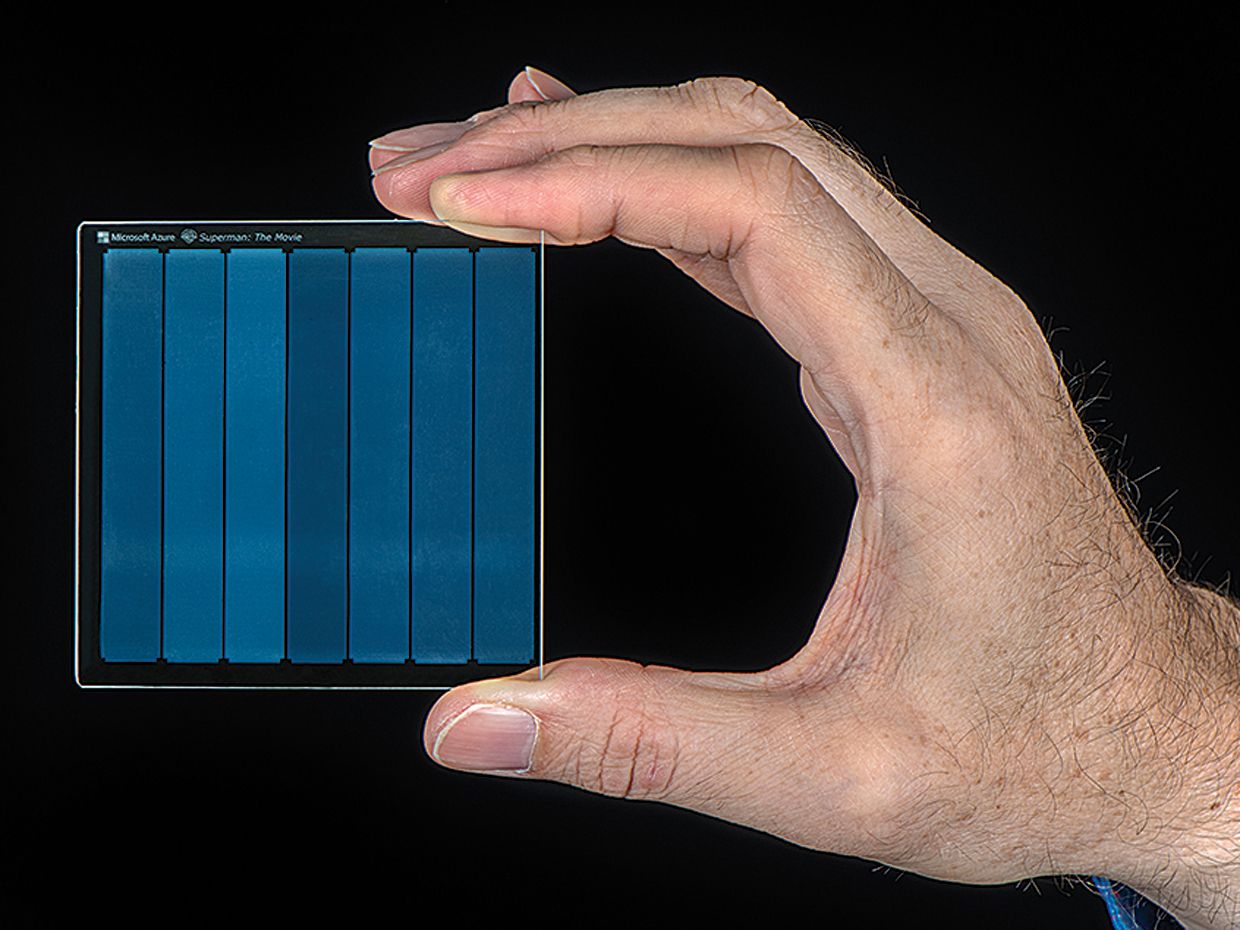Lasers Write Data Into Glass
 Photo: Microsoft Learning to Read: James Clegg, a senior optical scientist at Microsoft, loads a piece of glass into a system used to retrieve information stored in the glass.
Photo: Microsoft Learning to Read: James Clegg, a senior optical scientist at Microsoft, loads a piece of glass into a system used to retrieve information stored in the glass. Magnetic tape and hard disk drives hold much of the world's archival data. Compared with other memory and storage technologies, tape and disk drives cost less and are more reliable. They're also nonvolatile, meaning they don't require a constant power supply to preserve data. Cultural institutions, financial firms, government agencies, and film companies have relied on these technologies for decades, and will continue to do so far into the future.
But archivists may soon have another option-using an extremely fast laser to write data into a 2-millimeter-thick piece of glass, roughly the size of a Post-it note, where that information can remain essentially forever.
This experimental form of optical data storage was demonstrated in 2013 by researchers at the University of Southampton in England. Soon after, that group began working with engineers at Microsoft Research in an effort called Project Silica. Last November, Microsoft completed its first proof of concept by writing the 1978 film Superman on a single small piece of glass and retrieving it.
With this method, researchers could theoretically store up to 360 terabytes of data on a disc the size of a DVD. For comparison, Panasonic aims to someday fit 1 TB on conventional optical discs, while Seagate and Western Digital are shooting for 50- to 60-TB hard disk drives by 2026.
International Data Corp. expects the world to produce 175 zettabytes of data by 2025-up from 33 ZB in 2018. Though only a fraction of that data will be stored, today's methods may no longer suffice. We believe people's appetite for storage will force scientists to look into other kinds of materials," says Waguih Ishak, chief technologist at Corning Research and Development Corp.
Microsoft's work is part of a broader company initiative to improve cloud storage through optics. I think they see it as potentially a distinguishing technology from something like [Amazon Web Services] and other cloud providers," says James Byron, a Ph.D. candidate in computer science at the University of California, Santa Cruz, who studies storage methods.
Microsoft isn't alone-John Morris, chief technology officer at Seagate, says researchers there are also focused on understanding the potential of optical data storage in glass. The challenge is to develop systems that can read and write with reasonable throughput," he says.
 Photo: Microsoft Made to Last: Microsoft and Warner Bros. stored the 1978 film Superman on this piece of glass in a proof of concept for Project Silica. The glass contains 75.6 gigabytes of data plus error-correcting codes.
Photo: Microsoft Made to Last: Microsoft and Warner Bros. stored the 1978 film Superman on this piece of glass in a proof of concept for Project Silica. The glass contains 75.6 gigabytes of data plus error-correcting codes. Writing data to glass involves focusing a femtosecond laser, which pulses very quickly, on a point within the glass. The glass itself is a sort known as fused silica. It's the same type of extremely pure glass used for the Hubble Space Telescope's mirror as well as the windows on the International Space Station.
The laser's pulse deforms the glass at its focal point, forming a tiny 3D structure called a voxel. Two properties that measure how the voxel interacts with polarized light-retardance and change in the light's polarization angle-can together represent several bits of data per voxel.
Microsoft can currently write hundreds of layers of voxels into each piece of glass. The glass can be written to once and read back many times. This is data in glass, not on glass," says Ant Rowstron, a principal researcher and deputy lab director at Microsoft Research Lab in Cambridge, England.
Reading data from the glass requires an entirely different setup, which is one potential drawback of this method. Researchers shine different kinds of polarized light-in which light waves all oscillate in the same direction, rather than every which way-onto specific voxels. They capture the results with a camera. Then, machine-learning algorithms analyze those images and translate their measurements into data.
Ishak, who is also an adjunct professor of electrical engineering at Stanford University, is optimistic about the approach. I'm sure that in the matter of a decade, we'll see a whole new kind of storage that eclipses and dwarfs everything that we have today," he says. And I firmly believe that those pure materials like fused silica will definitely play a major role there."
But many scientific and engineering challenges remain. The writing process is hard to make reliable and repeatable, and [it's hard] to minimize the time it takes to create a voxel," says Rowstron. The read process has been a challenge in figuring out how to read the data from the glass using the minimum signal possible from the glass."
The Microsoft group has added error-correcting codes to improve the system's accuracy and continues to refine its machine-learning algorithms to automate the read-back process. Already, the team has improved writing speeds by several orders of magnitude from when they began, though Rowstron declined to share absolute speeds.
The team is also considering what it means to store data for such a long time. We are working on thinking what a Rosetta Stone for glass could look like to help people decode it in the future," Rowstron says.
This article appears in the June 2020 print issue as Storing Data in Glass."